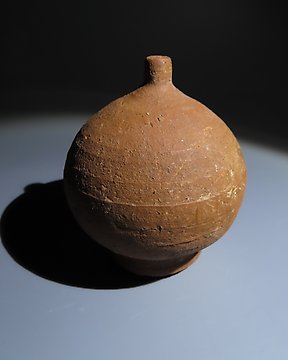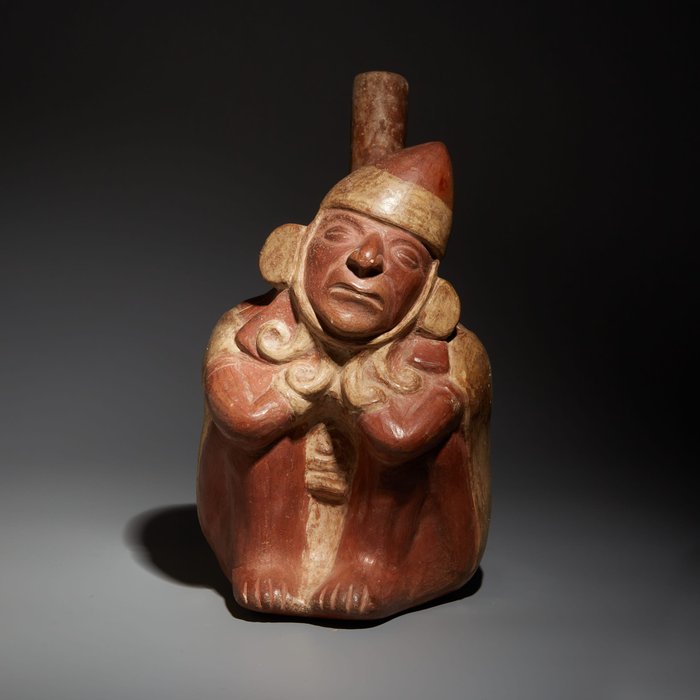
Etruski Terakota Wotywny model kobiecej piersi. IV - I wiek p.n.e. 9 cm wys. Bardzo rzadkie! Nienaruszony.
Nr 83804621

Nr 83804621

Stirrup Spout Bottle with Sleeping Warrior
- Thermoluminiscense Test -
CULTURE: Moche, Perú
PERIOD: 1st-4th century AD
MATERIAL: Terracotta
DIMENSIONS: Height 21 cm
CONDITION: Good condition. It has restorations on the handle.
PROVENANCE: Private collection, Paris, France. 1970.
DOCUMENTATION: Spanish Import license included.
DESCRIPTION:
This ceramic bottle was modeled in the shape of a sleeping warrior, with details of his attire rendered in white and reddish-brown slip (a suspension of clay and/or other colorants in water). The figure wears a conical helmet.
Figures with their feet drawn up is a relatively common pose in Moche art, yet the significance of this position is unclear. Is this an individual resting after an arduous battle? The interpretation of this imagery is challenged by the absence of historical texts dating to this period. This vessel was made by artists of the Moche culture, which flourished on Peru’s North Coast from 200-850 A.D., centuries before the rise of the Incas (Castillo, 2017). Over the course of some six centuries, the Moche built thriving regional centers from the Nepeña River Valley in the south to perhaps as far north as the Piura River, near the modern border with Ecuador, developing coastal deserts into rich farmlands and drawing upon the abundant maritime resources of the Pacific Ocean’s Humboldt Current. Although the Moche never formed a single centralized political entity, they shared unifying cultural traits such as religious practices (Donnan 2010).
Huacos are closed vessels with a spherical or sculpted body, a flat base and a tubular handle in the form of a stirrup. They have been and are one of the principal elements which allow us to know not only characteristics of this pre-Hispanic culture, but also of its society, the natural environment in which it developed and the different stages of its cultural evolution. Its name derives from huaca, the name referring to a tomb of this culture, as moreover, these vessels were destined to make up part of the grave goods of a deceased person.
The Moche culture inhabited the coast of present-day northern Peru, concentrating in the valleys of Lambayeque, Chicama, Moche and Virú. This desert region is crossed by several rivers that flow down into the Pacific Ocean, where marine resources are plentiful.
The Moche produced fine ceramic, textile and precious metal pieces. Their characteristic style can be seen in a wide range of goods such as fire-engraved gourds, wall murals, featherwork art, body painting and tattoos. Their ceramic decoration displays a level of skill that has rarely been surpassed, and included such techniques as incision, bas-relief with stamps, and painting on smooth surfaces. Many were made in state-run workshops that mass-produced pieces from molds. Their ceramics came in a variety of forms and decorative styles and displayed myths and ritual motifs as well. Notable among these earthenware forms were the so-called “portrait bottles”, bottles molded with the face of a well-known Moche figure. These highly detailed facial portraits reflect the Moche’s own use of face paint and/or tattoos, as well as elaborate headdresses. This portrait-making expertise can also be observed in everyday scenes and erotic representations, as well as in figures of individuals that were hunch backed, blind, or suffered from other disorders. They were skillful metalworkers, using gold, copper and silver to make ear ornaments, nose rings, bracelets, necklace beads, tweezers and a variety of tools. Especially notable is the tumi or ceremonial knife that was usually only carried by Moche officials.
Many of the motifs adorning early Moche ceramics were derived from the Recuay culture. These two peoples were certainly in contact, as all of the irrigation waters the Moche used in their valleys flowed down from Recuay territory. In the early years, the Moche also had contact with groups of the Salinar and Gallinazo cultures. It is very likely that the Moche disappeared when they were overtaken by the Wari Empire, but their civilization also suffered from long periods of flooding by the El Niño phenomenon, which would have destroyed their farming infrastructure and could have helped precipitate their collapse. The final stage of the Moche culture displays features that would later appear in the Chimú culture.
Notes:
The seller guarantees that he acquired this piece according to all national and international laws related to the ownership of cultural property. Provenance statement seen by Catawiki.
The seller will take care that any necessary permits, like an export license will be arranged, he will inform the buyer about the status of it if this takes more than a few days.
The piece includes authenticity certificate.
The piece includes Spanish Export License.
Jak kupować w serwisie Catawiki
1. Odkryj coś wyjątkowego
2. Złóż najwyższą ofertę
3. Dokonaj bezpiecznej płatności